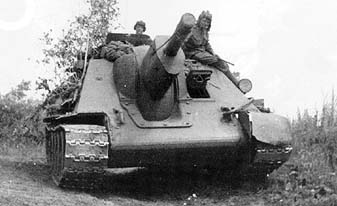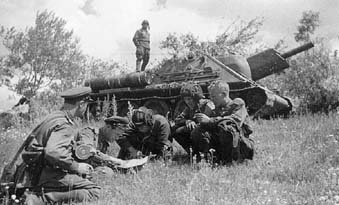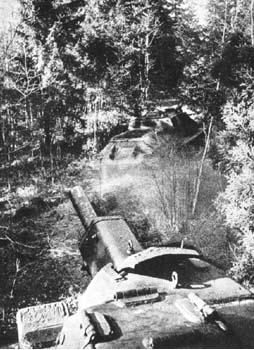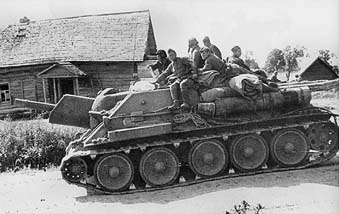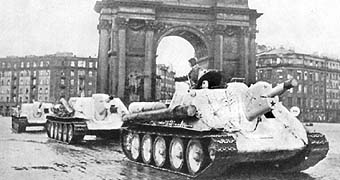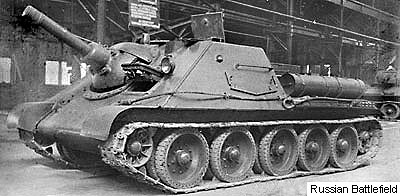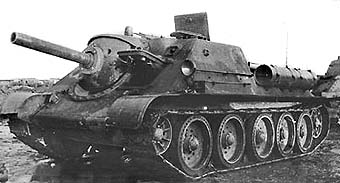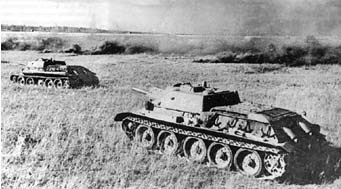| Language |
|---|
| Google Translation |
|---|
|
|
| Main Resources | |||||||||
|---|---|---|---|---|---|---|---|---|---|
|
| Additional Stuff | ||||
|---|---|---|---|---|
|
| Online Services | |||
|---|---|---|---|
|
| Miscellaneous | |||||||
|---|---|---|---|---|---|---|---|
|
 |
| Log in |
|---|
| Users online |
|---|
| We have 8 guests online |
| Search |
|---|

| SU-122 Assault Gun |
SU-122 Assault Gun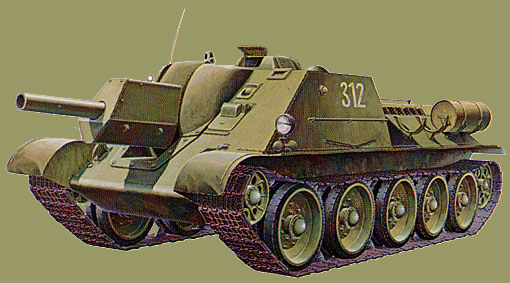
The success of the German StuG's did raise a big interest within the Soviet High Command. Assault guns were cheaper to produce, because of the absence of a turret and some other expensive elements. The larger compartment offered more room, so bigger and more powerful weapons could be installed in it. Because of the absence of a heavy turret, the vehicle's frontal armor could be increased as well. In April 1942, the GAU ordered several design bureaus to develop an assault guns with 122 mm armament or even greater. All work was coordinated by the Ministry of Tank Industry (Russian abbreviation - NKTP). Each bureau did offer it's own project. Two of these projects were manufactured "in metal". The first of them (U-35 designation) was developed by the Uralmash (Uralsky Machine-Building factory). The second was the SG-122(A) Self-Propelleg Gun, which was developed by the Factory #592. The U-35 was a fully armored assault gun, armed with the 122 mm M-30 howitzer, mounted in non-traversing compartments. The vehicle was based on the chassis of the T-34 medium tank. The SG-122 was armed with the same howitzer but was based on the chassis of an ex-German StuG III. In July 1942, the SG-122 was accepted for service, but was considered unsuccessful and hard to maintenance, so it was quickly removed from service. The U-35 was protected with 45 mm of frontal armor. The elevation angles of the M-30 were -3° +26°, the horizontal (traversing) angle ±10°. Engine and transmission were left unchanged to increase the production capability and keep the cost price low. The maximum range of the vehicle was increased by adding some external fuel tanks.
The crew of five men was placed as follows: driver's station at the left front hull, gunner's station at the left behind the driver, commander's station was at the right front and the two loaders (the M-30 loaded separately) were behind the howitzer's breech. In December 1942, after passing a full set of tests, the GKO ordered to manufacture a small installation party of SU-35 assault guns. Later on the vehicle was renamed SU-122. Till the end of 1942,a total of 25 assault guns were manufactured. The same month, the first mixed regiment was formed, partially equipped with these SP-guns. The regiment consisted of four batteries of SU-76s SP-guns (16+1 vehicles in total) and two batteries of SU-122s (eight vehicles total). At the end of January 1943, a pair of SU-122 regiments were put into action near Leningrad. In March 1943, another two SU-122 regiments were formed and sent to the front. The impression of the new regiments was different. Although the appearance of a new assault guns was met with delight, the use of SU-76's together with SU-122's caused many problems because of certain technical troubles with the SU-76. After they were improved, all SU-76's were re-organized in separate regiments of light self-propelled artillery, while SU-122's were used to form medium self-propelled artillery regiments. These Medium SP regiments consisted of 16 SU-122's (organized in four batteries) and one commander's T-34 tank. Soon, the new SU-122 became very popular due to it's quite powerful armament and good armor protection. In May 1943, the new BP-460A HEAT round was accepted. That ammunition allowed the SU-122 to deal with enemy AFV's at long distances successfully.
Although, even without any hollow-charge ammunition, the SU-122 could deal with heavy German tanks, including Tigers. This is a quotation from the original report written by Major Gomille, commander of the III.(Tiger) Abteilung/Panzer Regiment (Panzer-Division Grossdeutschland): "...Hauptmann von Villerbois, commander of the 10.Kompanie, was severely wounded during this action. His Tiger was hit eight times by 12.2 cm shells from the assault guns on T-34 chassis. One hit penetrated the hull side. The turret was hit six times, three of which resulted only in small dents, while two hits caused fractures and small pieces to break off. The six hit broke out a large piece (about two hand widths) from the turret armor that flew into the fighting compartment. The entire electrical firing circuit for the main gun was knocked out by the hits and several vision blocks were destroyed or broke out of the weak holders. The weld seam on the hull was sprung open for about 50 cm from the location of the penetration, so that it wasn't possible for the Werkstatt-Kompanie (maintenance company - Valeri Potapov) to repair it". 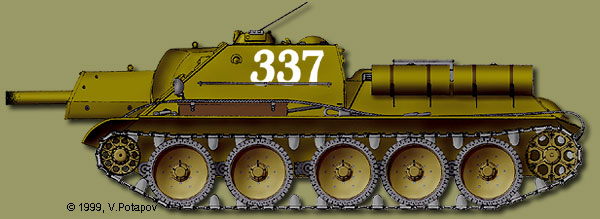 SU-122 Medium Assault Gun (V.Potapov)
The report was written on August 31, 1943. Obviously, this report is about SU-122s as they were single "assault guns based on T-34 chassis" at the time. The SU-85 and SU-100 appeared much later. Simultaneously with mass production, works on improvement of the existing SU-122 continued. In general, they were pointed at the reduction of production expenses. Nevertheless, in March 1943, the Uralmash offered a project of drastic modernisation of the SU-122. The new variant did receive the SU-122M designation. It had a new compartment, in which the 122 mm U-11 howitzer was mounted. That howitzer had passed the comparative trials together with the KV-9 experimental tank. One of the two loaders was excluded from the crew due to the improved aiming mechanism. The U-11 howitzer has supplied with the same ammunition as the M-30 Howitzer. The driver's hatch-stopper was replaced with a tip-up hatch. The governmental trials of the SU-122M did reveal many defects and serious drawbacks in it's design. The reliability of the vehicle was also far from perfect, it's chassis was overloaded. The cost price was very high. Because of this, SU-122M wasn't accepted for service. In spite of that rebuff, Uralmash did offer another variant of modernisation. It was based on the new concept of total unification of basic elements and parts of Soviet tanks. The projected assault gun was highly unified with the SU-85. Its hull was redesigned, the 85 mm D-5T was replaced with the 122 mm D-6 howitzer, which was more compact then U-11 but with the same ballistics and ammunition. The gun's mantlet did not alter. The new vehicle was named SU-122-3. It was sent to comparative trials together with some other modernised SU-85 SP-guns. Notwithstanding the negative experience of SU-122M, the new vehicle was very unreliable. It didn't pass the trials, and wasn't accepted for service. All further work was cancelled. Later in 1944, a small number of SU-122's were based on the SU-100 chassis, however that modification wasn't put in mass production. The manufacturing of the SU-122 continued up to summer 1944. Totally 1100 of them were manufactured.
No. 1 : The Combat AFV Family based on the T34 chassis I believe that this weapon was the archetypal Assault Gun, worthy of the designation much more so than the often mentioned StuG lll and StuH 42 vehicles produced by Germany on the Panzer lll chassis. No German AFV was armed with such a useful large--bore support weapon as the M-30 Gun/Howitzer. Even the SturmPanzer lll and lV AFVs, which were armed with the short-range sIG-33, fell well short of the mark compared to the COBET SU 122. As an American, I feel embarassed to mention that our( U.S.) Armored Forces NEVER produced an effective close support AFV during the period of the Great Patriotic War. In the end, we relied on towed Tube Artillery (such as the 155mm Gun M1/L45), and multiple rail Rocket launchers (like the 60 tube 114mm bore "Caliope"), to saturate enemy Area targets and entrenched positions with High Explosive rounds. These weapons, when used on point targets, however, are often fairly ineffective, where a well--armored direct fire weapon like the SU 122 seems more or less ideal. Also, the towed guns usually cannot keep pace with the Armored forces as they advance. Svaseebo, moi droogim --Wild One J! Reactions Commenting Software General Site License Copyright © 2006 S. A. DeCaro |
||||||
|
© The Russian Battlefield, 1998 Webdesign: |



